Combining yoga and meditation can create a powerful practice that enhances both physical and mental well-being. By weaving together the mindful movements of yoga with the stillness of meditation, you can cultivate a deeper connection to your body and mind. This guide will show you how to seamlessly integrate these two practices into your routine for a more balanced and fulfilling experience.
Creating a Balanced Routine: Integrating Yoga and Meditation

Combining yoga and meditation can lead to a more balanced routine. The calendar image showcases various yoga sessions planned throughout the month, emphasizing consistency and intention in practice.
Each day offers unique sessions, such as ‘Gentle Yoga’ or ‘Mindful Meditation.’ This variety helps keep things fresh and engaging. You can easily tailor your routine based on your energy levels and personal preferences.
Consider scheduling specific days for yoga and others for meditation. This way, you can enjoy focused time on each practice without feeling rushed. For instance, you might do yoga on weekdays to energize your mornings, while saving meditation for weekends to unwind.
Using a calendar like the one in the image can help you stay organized and motivated. Mark your sessions and set reminders. Having a visual guide keeps your goals front and center. Remember, the key is to find a rhythm that works for you.
Choosing the Right Environment for Practice
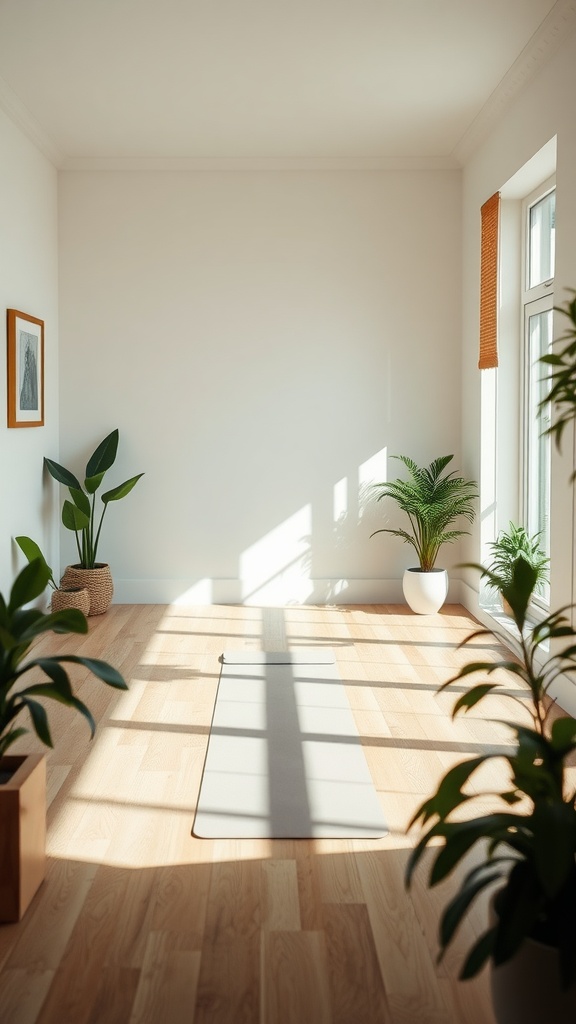
Creating the right space for yoga and meditation can make a big difference in your practice. Look at the image: it shows a bright, open room with a simple yoga mat in the center. The soft sunlight streaming through the window adds a warm touch, making it inviting to step onto the mat.
Surrounding the mat are some lovely plants that help bring a sense of nature indoors. Incorporating greenery can enhance your experience by providing a calming atmosphere. Plants are known to improve air quality, which can be refreshing while you practice.
The room is uncluttered, which is important. A simple environment allows for fewer distractions, helping you focus more on your breathing and movements. Choose a space that feels peaceful and supports your intention to connect with your body and mind.
Light is another critical factor. Natural light, like in this image, can lift your mood and energize your practice. If possible, find a room with good windows or consider using soft lighting that mimics daylight. This can create a welcoming vibe whether you’re doing yoga poses or meditating.
Understanding the Synergy Between Yoga and Meditation

In the serene image before us, three individuals sit peacefully in a beautiful natural setting, embodying the essence of yoga and meditation. The backdrop features majestic mountains and a tranquil lake, creating a perfect environment for inner reflection and connection with nature. This imagery reflects how practicing yoga and meditation together can enhance our well-being.
Yoga is often seen as a physical practice, involving various postures that help to strengthen the body. However, it also serves as a gateway to meditation. When we move our bodies through yoga, we cultivate awareness of our breath and thoughts, setting the stage for deeper meditation. The individuals in the image highlight this balance, each in a meditative pose, promoting harmony between body and mind.
Moreover, meditation provides a mental space to let go of distractions and focus inward. In this peaceful landscape, free from interruptions, the practitioners can fully immerse themselves in their thoughts and feelings. By combining these two practices, we can achieve a state of relaxation and clarity, allowing for personal growth and stress relief.
As we can see in the image, the vibrant flowers and gentle breeze add to the calming atmosphere, suggesting that nature can play a significant role in enhancing our practice. Whether you’re in a studio or outside like these practitioners, finding a serene space is essential. Embracing both yoga and meditation can lead to a fulfilling journey of self-discovery and wellness.
Mindfulness Practices to Enrich Your Yoga Flow
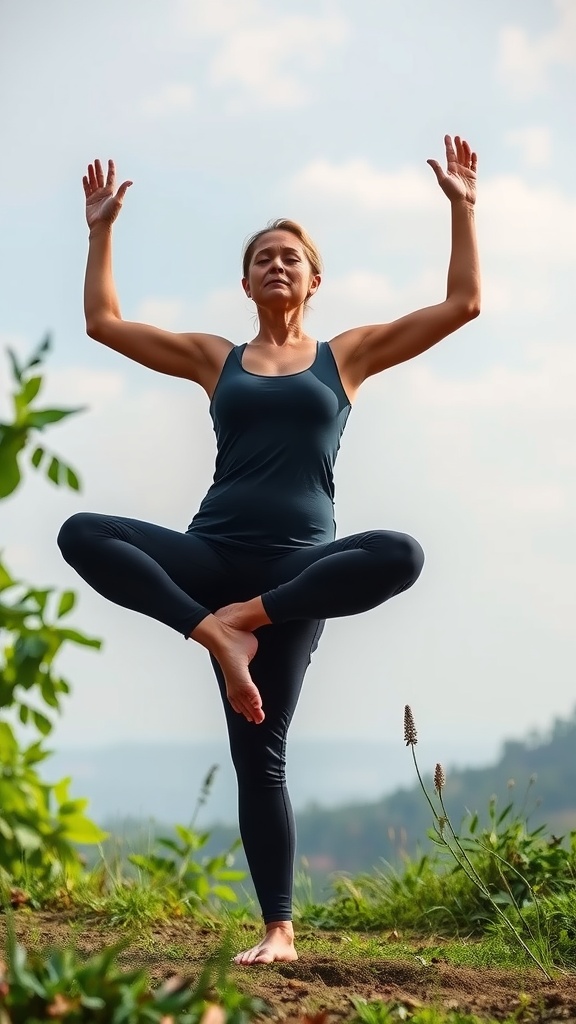
Imagine a serene landscape where the sky meets lush greenery. In the midst of this tranquility, a person practices yoga, embodying calmness and focus. With one leg raised and arms outstretched, they find balance in both body and mind. This scene perfectly captures the essence of combining yoga and mindfulness.
Integrating mindfulness into your yoga practice can transform your flow. It encourages you to be present, enhancing your physical movements with mental clarity. When you’re in the moment, each pose becomes more meaningful.
Start by focusing on your breath. Inhale deeply as you transition between poses, and exhale slowly to release any tension. This simple act of breathing connects your body and mind, allowing you to fully experience each stretch and movement.
Another way to deepen your mindfulness is through visualization. Picture a peaceful setting, like the one in the image, as you practice. Let this visualization guide you, helping you to remain centered and calm.
Finally, consider adding meditation at the end of your yoga session. Sitting quietly, reflect on your practice and how you felt during each pose. This will enhance your overall experience, making your practice not just physical, but a journey into relaxation and self-awareness.
Breathwork: The Bridge Between Yoga and Meditation
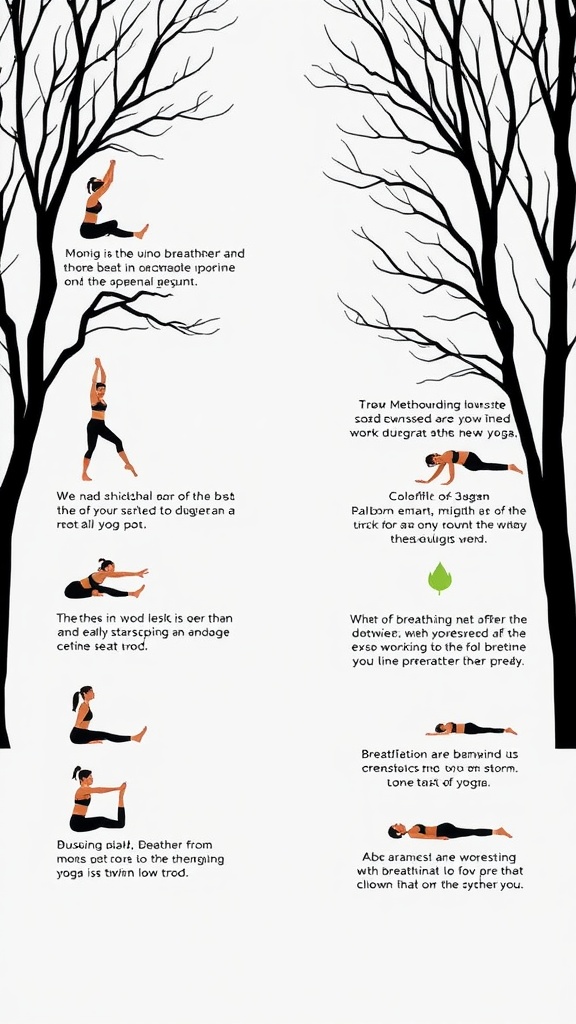
Breathwork is a fundamental aspect of both yoga and meditation, serving as a gentle bridge that connects the two practices. In the image, different breathing techniques are illustrated alongside yoga poses, highlighting how breath can enhance both physical movement and mental clarity.
As you look at the figures in the image, notice how each pose aligns with specific breathing techniques. The acts of inhaling and exhaling are not just about oxygen; they are about finding rhythm, focus, and calm. Whether you are flowing through a sun salutation or settling into a moment of stillness, breath is your constant companion.
The left side of the image illustrates various yoga poses, each paired with a suggested breathing pattern. This visual representation emphasizes that breathwork is integral to maximizing the benefits of yoga. For example, deep inhalations can energize the body in a challenging pose, while slow, controlled exhalations can help release tension.
On the right, the meditation techniques reflect how breath serves as an anchor for mindfulness. The image captures the essence of being present, suggesting that by focusing on your breath, you can quiet the mind and deepen your meditation practice. The intention is clear: breath is the thread that weaves together the physical and mental facets of well-being.
In summary, incorporating breathwork into your yoga and meditation routines can enhance your overall experience. By synchronizing your breath with movement and stillness, you create a harmonious flow that nurtures both body and mind.
Setting Intentions: A Pre-Yoga Meditation Ritual
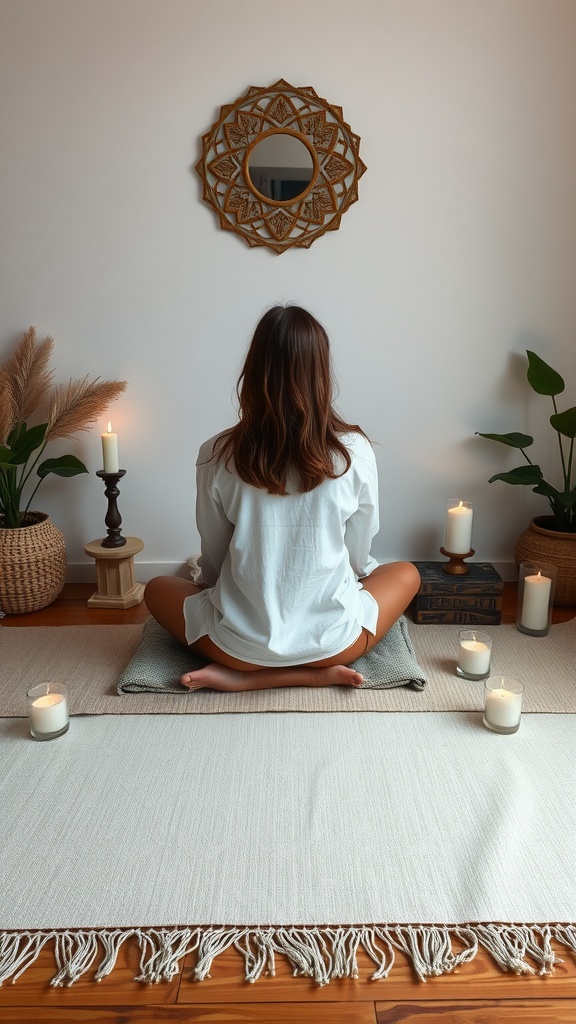
Before diving into your yoga practice, taking a moment to set intentions can truly enhance your experience. The image above beautifully captures a serene space perfect for this ritual. With candles softly glowing and plants adding a touch of nature, it creates a calming atmosphere.
In this setup, we see someone sitting comfortably, ready to meditate. This peaceful environment encourages relaxation and focus. The soft textures of the rugs and the woven elements around enhance the feeling of coziness, inviting you to reflect.
Start by settling into a comfortable position, just like our friend in the image. Close your eyes and take a few deep breaths. With every inhale, imagine filling your body with positive energy, and with each exhale, release any tension or distractions. This is the time to think about what you want to achieve in your yoga session.
As you meditate, visualize your intentions. Whether it’s finding balance, increasing strength, or simply being present, let those thoughts guide you. By taking this time, you’re not just preparing your body but also your mind for a fulfilling practice.
Once you feel centered, you can flow into your yoga routine with clarity and purpose. This simple pre-yoga meditation ritual can make a significant difference in how you connect with your practice.
Exploring Different Yoga Styles for Meditation Enhancement
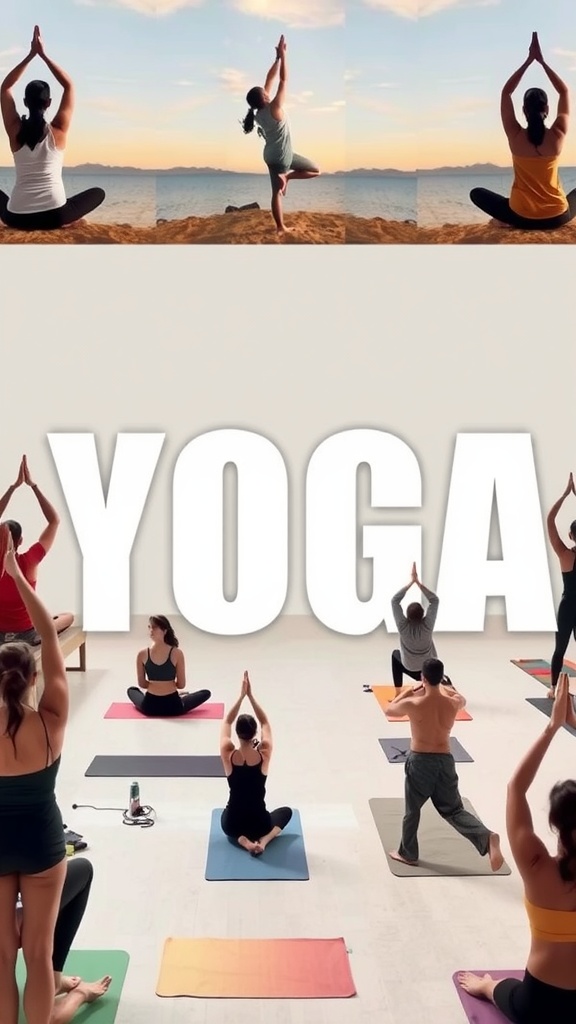
The image captures the essence of yoga and meditation beautifully. It features a range of practitioners engaging in various yoga poses, highlighting the diversity of styles. The vibrant colors of their mats create an inviting atmosphere, and the serene background suggests a peaceful retreat.
Yoga can play a big role in enhancing meditation practices. Different styles offer unique benefits, making it easier to find one that suits your needs. For instance, Hatha yoga focuses on gentle movements and breath control, which can be a great way to prepare your body for meditation.
Vinyasa, on the other hand, flows from one pose to another, linking breath with movement. This style can help you release tension and cultivate mindfulness, setting the stage for a deeper meditation experience. Incorporating a few minutes of Vinyasa before your meditation can clear your mind and help you focus.
Another style worth exploring is Yin yoga. This slower-paced practice encourages deep stretching and relaxation. Holding poses for longer periods allows for introspection and can lead to a more centered state of mind, perfect for meditation.
So, whether you’re drawn to the flexibility of Vinyasa or the relaxation of Yin, blending these yoga styles with your meditation routine can make your sessions more fulfilling. Try mixing them up to see what resonates with you!
Techniques to Enhance Focus During Meditation
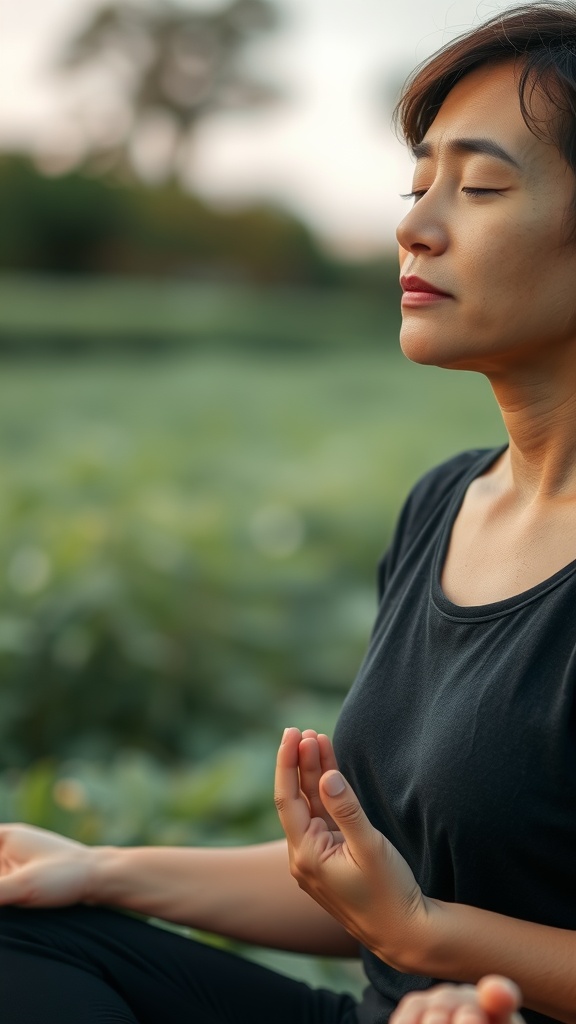
In the image, we see a person deeply engaged in meditation, highlighting the importance of focus in this practice. The serene environment around her encourages a sense of calm and concentration. Her closed eyes and relaxed posture suggest that she is fully immersed in her meditation, allowing her thoughts to settle. This visual representation aligns perfectly with our goal of enhancing focus during meditation.
One effective technique to improve focus is to adopt a comfortable posture, just like the person in the image. Sitting upright helps maintain alertness while allowing for relaxation. You can also try different positions, like cross-legged or seated on a chair, to find what feels best for you.
Breath awareness is another key aspect. Focusing on each inhale and exhale can help anchor your mind. When you notice your thoughts wandering, gently redirect your attention back to your breath. This simple practice can significantly improve your concentration.
Incorporating mindfulness is also beneficial. Pay attention to the sensations in your body and the sounds around you. This practice helps ground you in the present moment, reducing distractions. Just as the individual in the photo seems to embrace her surroundings, you can too.
Lastly, consider using a mantra. Repeating a word or phrase during meditation can provide a mental focal point. This method can help quiet the mind, similar to how the calmness of the setting in the image supports a peaceful meditation experience.
Tracking Progress: Journaling Your Yoga and Meditation Journey
![]()
Journaling is a powerful way to track your yoga and meditation journey. In the image, we see an open journal bathed in natural light, with pages filled with handwritten notes. This scene encapsulates the essence of reflecting on personal growth.
Writing in your journal allows you to document your thoughts, feelings, and experiences before and after each session. You can jot down what poses you practiced or which meditation techniques resonated with you. Over time, this record can help you identify patterns and areas for improvement.
Consider using prompts to guide your writing. Questions like ‘How did my body feel today?’ or ‘What thoughts came up during meditation?’ can lead to deeper insights. As you read back through your entries, you may notice shifts in your mindset and flexibility, both physically and mentally.
Moreover, journaling can enhance your mindfulness practice. It creates a space to pause and reflect, which is essential for personal growth. So grab that journal and start penning down your journey!
The Role of Sound and Music in Joint Practices
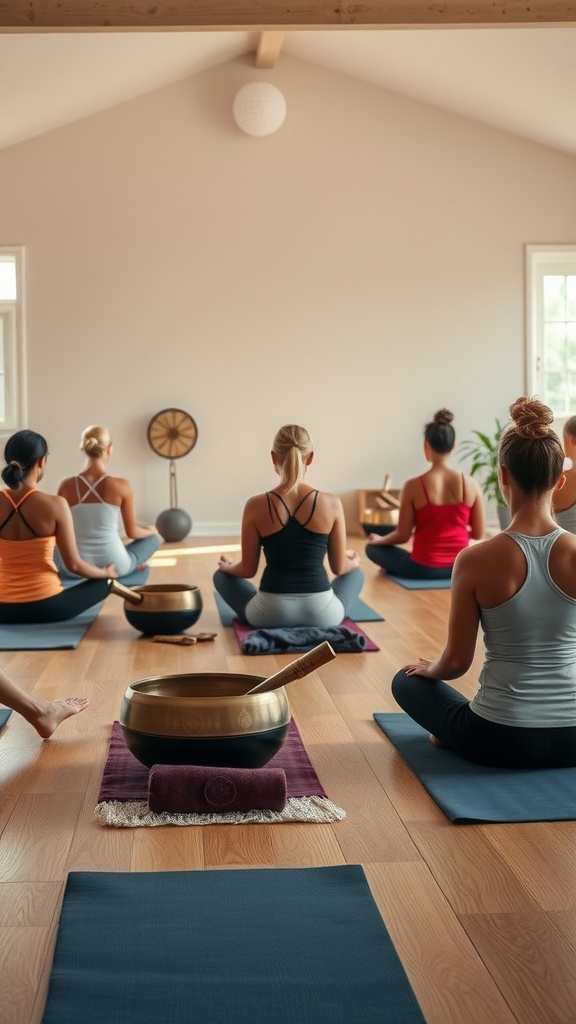
In the serene environment captured in the image, a group of individuals sits in a calming space, preparing to engage in yoga and meditation. The absence of distractions allows them to focus inwardly. The circular bowls positioned in front of them suggest that sound will play a crucial role in their practice.
Sound and music can greatly enhance the experience of yoga and meditation. Many practitioners find that soothing sounds help them relax and achieve a deeper state of mindfulness. The gentle tones from singing bowls, like those in the image, can create vibrations that resonate both physically and emotionally, promoting a sense of peace.
Using music during yoga can also set the mood for the session. Soft, melodic tunes can help regulate breathing and guide movements, making each pose more fluid. It encourages participants to stay present, while also creating a shared atmosphere of tranquility.
As you combine yoga and meditation, consider incorporating sound intentionally. Try starting your session with the calming sounds of nature or gentle instrumentals. This can help ease you into your practice and prepare your mind for meditation. The incorporation of sound not only enriches the experience but also fosters a deeper connection between your mind, body, and spirit.